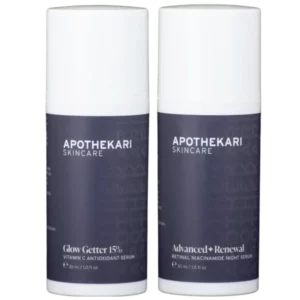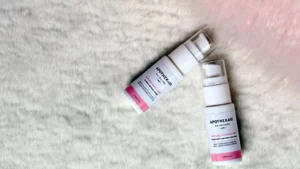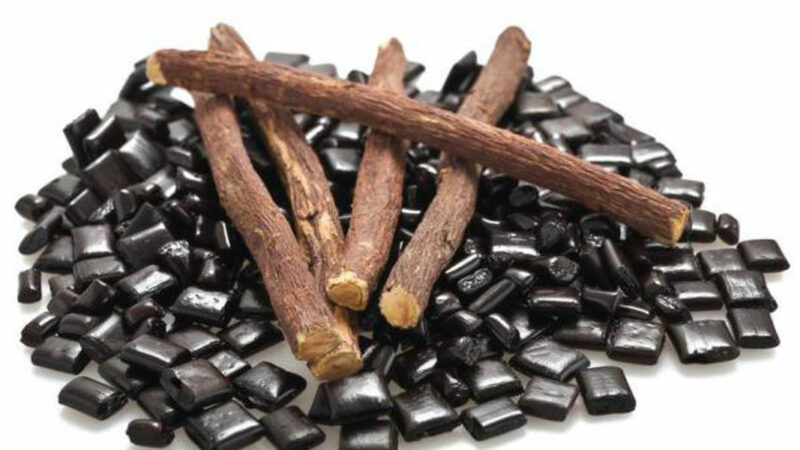Want to avoid sun damaged skin this, and every, summer? Learn how in this post!
Also known as premature aging or photoaging, sun damage refers to skin that’s been wrecked by exposure to the sun’s harmful ultraviolet (UV rays). There are ways to prevent, and to repair, some of this damage. Read on for more information.
shop APOTHEKARI RADIANT SKIN SET
Do You Have Sun Damaged Skin?
Every time you go outside or sit by a window without sun protection, or use a tanning bed, you’re putting yourself at risk for skin damage. Over time, this damage can build up, leading to skin changes making you look years older than you normally would.
Changes include:
- Wrinkles and fine lines
- Age spots and other pigmentation
- Loose skin
- Spider veins
- Blotchy or ruddy complexion
Tanning beds can cause these changes to occur very quickly, sometimes in as little as a year! The damage can lead to deeper lines or dry, scaly patches – actinic keratoses (AKs), pre-cancerous skin growth, which can lead to skin cancer.
You Can Protect Against Sun Damaged Skin.
Reverse It Also
The best way to decrease your chances of sun damaged skin is to protect yourself from the sun’s UV rays.
- Don’t sit out with unprotected skin – wear long sleeves and put on sunglasses
- Seek shade wherever possible
- Minimize sun exposure when UV rays are strongest, between 10 am and 4 pm.
- Use a well-formulated sunscreen with a minimum SPF 30 whenever possible. Curious about how to use sunscreen properly? Read how to apply sunscreen correctly.
Adding in an antioxidant formulation like our Bespoke Vitamin C Serum, helps protect skin further. Antioxidants like vitamin C and E and green tea, are antioxidants that help protect skin from the free radical damage that comes with sun exposure. Free radicals are unstable molecules that attack skin’s proteins (collagen and elastin, for example), lipids and worst of all, DNA. Antioxidants help protect against this kind of damage. We like to apply Bespoke Vitamin C every morning underneath our sunscreen.
Already have skin that’s damaged? Retinoids, a class of ingredients that come from Vitamin A, have been shown to help reverse some of the damage. Retinoids boost collagen production in skin, helping to maintain its firmness. Our A is for Anti-Aging Serum contains retinaldehyde, a gentle and highly effective retinoid, along with other actives, which helps to reduce the appearance of wrinkles and fine lines, brighten skin, reduce hyperpigmentation and protect it against sun damage.
Find both serums in our Radiant Skin Set.

Is It Time to Visit Your Dermatologist?
If your skin is seriously sun damaged, and you’ve tried topical treatments without much success, you may want to check in with your dermatologist. A dermatologist can help to determine if a prescription treatment may be more suitable. Or, if you’re a candidate for a medical procedure:
- Laser Resurfacing. Intense beams of light can remove layers of sun damaged skin and trigger the formation of collagen, leaving skin looking healthier
- Chemical Peels. Strips away sun-damaged skin
- Photorejuvenation (also known as intense pulsed light – IPL). Bursts of pulsed light are used to reach the deeper layers of skin and smooth out sunspots and freckles
- Microdermabrasion. Buffs off the top layer of skin with sand-like particles, which stimulates the growth of new skin underneath.
- Bleaching Creams. Bleaching chemicals smooth out uneven skin coloring.
Sun Damaged Skin – Prevention is Always Best!
Wear sunscreen every day. Minimize sun exposure. Add in an antioxidant and a retinoid into your skincare routine. There’s really no reason for sun damaged skin. We can keep our skin looking good for decades if we just take care of it.






